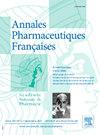Development and in vitro-in vivo evaluation of ocular insert containing ketorolac tromethamine and moxifloxacin hydrochloride
IF 1.1
Q4 PHARMACOLOGY & PHARMACY
引用次数: 0
Abstract
Purpose
Conjunctivitis is a common eye disorder that causes swelling and inflammation of the conjunctiva. Topical dosage form containing antibiotics and non-steroidal anti-inflammatory drugs are prescribed for the treatment and in order to overcome problems of conventional dosage forms the present study aims to develop an ocular insert containing moxifloxacin HCl and ketorolac tromethamine.
Methods
Insert was prepared by a solvent casting method by taking different polymers PVA, PVP K-30, and a combination of both as film-forming polymer, and glycerol as a plasticizer and characterized by various parameters like thickness, folding endurance, pH, swelling index, drug content, mechanical properties, in vitro and in vivo release study.
Results
The formulation prepared by a combination of both polymers demonstrated significantly improved properties including % elongation, tensile strength, swelling index, drug content and drug release compared to the formulation made with single polymer. The in vitro release data indicated that the batch R8 exhibited sustain release of drug (85% release in 10 hr) and following the Higuchi model for release kinetics. In vivo, study in rabbit eyes revealed the sustained release of the drug up to 16 hr with a good correlation between in vitro and in vivo release data.
Conclusion
From the study, it can be concluded that the developed ocular insert can be a promising formulation for rational therapy of conjunctivitis.
Objectif
La conjonctivite est un trouble oculaire courant qui provoque un gonflement et une inflammation de la conjonctive. La présente étude vise à développer un insert oculaire contenant de la moxifloxacine HCl et du kétorolac trométhamine.
Méthodes
L’insert a été préparé par une méthode de coulée au solvant en prenant différents polymères PVA, PVP K-30 et une combinaison des deux comme polymère filmogène et du glycérol comme plastifiant et caractérisé par divers paramètres tels que l’épaisseur, l’endurance au pliage, pH, indice de gonflement, teneur en médicament, propriétés mécaniques, étude de libération in vitro et in vivo.
Résultats
La formulation préparée à partir d’une combinaison des deux polymères a démontré des propriétés significativement améliorées, notamment le pourcentage d’allongement, la résistance à la traction, l’indice de gonflement, la teneur en médicament et la libération du médicament, par rapport à la formulation composée d’un seul polymère. Les données de libération in vitro ont indiqué que le lot R8 présentait une libération prolongée du médicament (libération de 85 % en 10 heures) et suivait le modèle Higuchi pour la cinétique de libération. In vivo, des études réalisées dans des yeux de lapin ont révélé la libération prolongée du médicament jusqu’à 16 heures avec une bonne corrélation entre les données de libération in vitro et in vivo.
Conclusion
De l’étude, on peut conclure que l’insert oculaire développé peut être une formulation prometteuse pour le traitement rationnel de la conjonctivite.

开发含有酮咯酸氨基丁三醇和盐酸莫西沙星的眼药水,并对其进行体外-体内评估。
目的:结膜炎是一种常见的眼部疾病,会导致结膜肿胀和发炎。为了克服传统剂型存在的问题,本研究旨在开发一种含有盐酸莫西沙星和甲氧氯雷他敏的眼部插件:采用不同的聚合物 PVA、PVP K 30 和两者的组合作为成膜聚合物,以甘油作为增塑剂,通过溶剂浇铸法制备眼药水,并通过厚度、耐折度、pH 值、膨胀指数、药物含量、机械性能、体外和体内释放研究等各种参数对其进行表征:结果:与单一聚合物制备的配方相比,两种聚合物混合制备的配方在伸长率、拉伸强度、膨胀指数、药物含量和药物释放等方面都有明显改善。体外释放数据表明,批次 R8 表现出持续的药物释放(10 小时内释放 85%),并遵循 Higuchi 释放动力学模型。在兔子眼睛中进行的体内研究表明,药物的持续释放时间长达 16 小时,体外和体内释放数据之间具有良好的相关性:从这项研究中可以得出结论,所开发的眼用插入物是一种很有前途的配方,可用于结膜炎的合理治疗。
本文章由计算机程序翻译,如有差异,请以英文原文为准。
求助全文
约1分钟内获得全文
求助全文
来源期刊

Annales pharmaceutiques francaises
PHARMACOLOGY & PHARMACY-
CiteScore
1.70
自引率
7.70%
发文量
98
期刊介绍:
This journal proposes a scientific information validated and indexed to be informed about the last research works in all the domains interesting the pharmacy. The original works, general reviews, the focusing, the brief notes, subjected by the best academics and the professionals, propose a synthetic approach of the last progress accomplished in the concerned sectors. The thematic Sessions and the – life of the Academy – resume the communications which, presented in front of the national Academy of pharmacy, are in the heart of the current events.
 求助内容:
求助内容: 应助结果提醒方式:
应助结果提醒方式:


